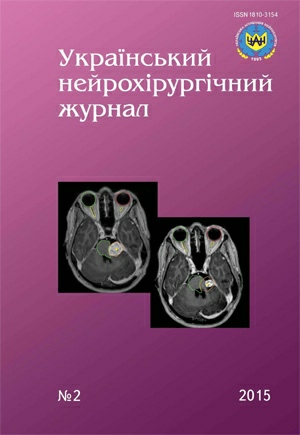Structural features and diagnostics of axis maldevelopments, a differentiated choice of surgical tactics
DOI:
https://doi.org/10.25305/unj.45292Keywords:
first and second cervical vertebrae, anatomy, variants of development, anomalies and maldevelopments, surgical treatmentAbstract
Purpose. To study X-ray anatomy of craniovertebral zone considering structural features of the second cervical vertebra for differential diagnosis of pathology and its variable anatomy in the clinical aspect.
Materials and methods. In the period from 2004 to 2014 in the clinic 43 patients were examined, maldevelopments of the dens of the second cervical vertebra (CII) were revealed. Clinical and radiological examinations were conducted, with functional tests, CT, MRI.
Results. We used differentiated approach to: fixation of CI–CII vertebrae; craniovertebral fixation involving CI–CII vertebrae; decompression of CI–CII vertebrae; decompression on craniovertebral level involving CI–CII vertebrae. After spinal cord compression riddance it’s necessary to perform locking operations. Regression of symptoms in average was 1.8 points on ASCIA scale. Long-term results were studied in terms up to 10 years, in average 3.2 years.
Conclusions. Variants of axis dens development were revealed in 20% cases; in some of them there were individual development options, in others — anomalies and maldevelopments. Anomalies and maldevelopments with craniovertebral disorders or secondary pathological conditions with danger of severe neurological disorders are indications for surgical stabilization of craniovertebral, zone, suboccipital decompression and laminectomy. Features of axis dens anatomy are often misinterpreted that causes difficulty in decision about indications for use of different methods of surgical treatment and rehabilitation, prognosis and expert diagnostics.
References
Anisimova Ye. Forma i razmery sustavnykh poverkhnostey anlantozatylochnogo sustava pri raznykh kraniotipakh. Makro- i mikromorfologiya: Mezhvuz sb nauch tr. 2005:33-36. Russian
O`Donnell C, Child Z, Nguyen Q, Anderson P, Lee M. Vertebral Artery Anomalies at the Craniovertebral Junction in the US Population. Spine. 2014;39(18):E1053-E1057. CrossRef
Udayakumaran S. Rare Manifestation of a Craniovertebral Junction Anomaly: Is Blue Breath Holding Always Benign?. Pediatr Neurosurg. 2013;49(5):297-299. CrossRef
Madhugiri V, Bhagavatula I. Congenital Anomalies at the Craniovertebral Junction–Posterior Fossa Region: Report of Two Cases. Journal of Neurological Surgery Part A: Central European Neurosurgery. 2013;74(S 01):e279-e283. CrossRef
Ratkin IK. Neyrokhirurgicheskoye lecheniye kraniovertebralnykh anomaliy [Neurosurgical treatment craniovertebral anomalies] [dissertation]. Novokuznetsk (Russia): 1990. Russian.
Kosinskaya N. Narusheniya Razvitiya Kostno-Sustavnogo Apparata. Leningrad: Meditsina; 2002:196. Russian.
Kumar R, Kalra S, Vaid V, Sahu R, Mahapatra A. Craniovertebral Junction Anomaly with Atlas Assimilation and Reducible Atlantoaxial Dislocation: A Rare Constellation of Bony Abnormalities. Pediatric Neurosurgery. 2008;44(5):402-405. CrossRef
Smith J, Shaffrey C, Abel M, Menezes A. Basilar Invagination. Neurosurgery. 2010;66(Supplement):A39-A47. CrossRef
Skrzat J, Mróz I, Jaworek J, Walocha J. A case of occipitalization in the human skull. Folia Morphol (Warsz). 2010;69:134-137. PubMed
Hong J, Lee S, Son B et al. Analysis of anatomical variations of bone and vascular structures around the posterior atlantal arch using three-dimensional computed tomography angiography. Journal of Neurosurgery: Spine. 2008;8(3):230-236. CrossRef
Klimo P, Rao G, Brockmeyer D. Congenital Anomalies of the Cervical Spine. Neurosurgery Clinics of North America. 2007;18(3):463-478. CrossRef
Vissarionov SV, Popov IV. Vrozhdennyye poroki pozvonochnika: voprosy embriogeneza, formirovaniya i razvitiya nekotorykh anomaliy. Vestn Sankt-Peterburg gos med akad im II Sechenova. 2006;2:146-150. Russian.
Zaychenko A, Anisimova Ye, Aleshkina O. Stereotopometriya kraniovertebral'noy oblasti cheloveka. Makro- i mikromorfologiya: mezhvuz sb nauch tr. 1999;4:73-76.
Mudaliar RP, Shetty S, Nanjundaiah K, Kumar JP, Kc J. An osteological study of occipitocervical synostosis: its embryological and clinical significance. J Clin Diagn Res. 2013;7(9):1835-7. CrossRef
Bobrik I. Atlas Anatomii Novorozhdennogo. Kiev: Zdorov'ia; 1990.
Li L, Yu X, Wang P, Chen L. Analysis of the treatment of 576 patients with congenital craniovertebral junction malformations. Journal of Clinical Neuroscience. 2012;19(1):49-56. CrossRef
Vissarionov S, Ul'rikh E, Mushkin A, Gubin A. Khirurgicheskoye ustraneniye nestabil'nosti pri vrozhdennykh porokakh pozvonochnika u detey. Vestn khirurgii im II Grekova. 2004;2:62-66. Russian.
Chandra P, Gupta A, Mishra N, Mehta V. Association of craniovertebral and upper cervical anomalies with dermoid and epidermoid cysts: report of four cases. Neurosurgery. 2005;56(5):1155. PubMed
Yin Y, Yu X, Zhou D et al. Three-Dimensional Configuration and Morphometric Analysis of the Lateral Atlantoaxial Articulation in Congenital Anomaly With Occipitalization of the Atlas. Spine. 2012;37(3):E170-E173. CrossRef
Downloads
Published
How to Cite
Issue
Section
License
Copyright (c) 2015 Eugene Pedachenko, Eugene Slynko, Tatyana Malyshevа, Oleg Robak, Oksana Chernenko

This work is licensed under a Creative Commons Attribution 4.0 International License.
Ukrainian Neurosurgical Journal abides by the CREATIVE COMMONS copyright rights and permissions for open access journals.
Authors, who are published in this Journal, agree to the following conditions:
1. The authors reserve the right to authorship of the work and pass the first publication right of this work to the Journal under the terms of Creative Commons Attribution License, which allows others to freely distribute the published research with the obligatory reference to the authors of the original work and the first publication of the work in this Journal.
2. The authors have the right to conclude separate supplement agreements that relate to non-exclusive work distribution in the form of which it has been published by the Journal (for example, to upload the work to the online storage of the Journal or publish it as part of a monograph), provided that the reference to the first publication of the work in this Journal is included.









